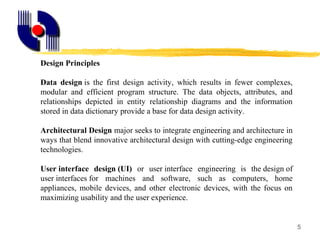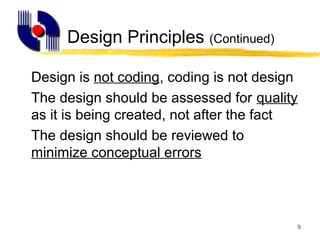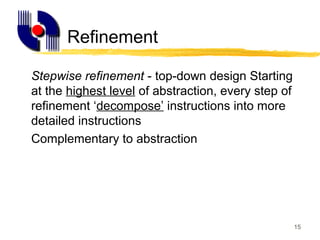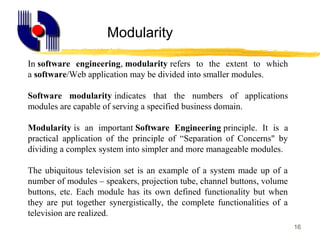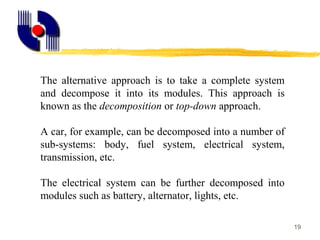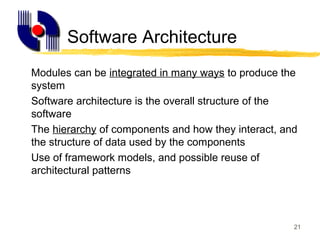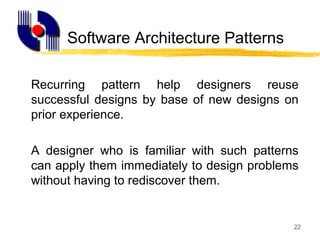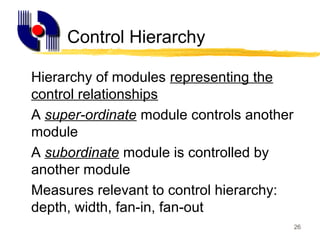Se ii unit2-software_design_principles
- 1. 1 Software Design Principles “Producing the software blueprint”
- 2. 2 Lecture Objectives To understand the importance of design in developing quality software To describe the translation from the requirements analysis model to the design model To understand the principles that guide proper design of software
- 3. 3 What Is Design? Explaining the idea/concept of something Usually with graphical diagrams With the intention to build The design is a representation of a product or a system with sufficient detail for implementation
- 5. 5 Design Principles Data design is the first design activity, which results in fewer complexes, modular and efficient program structure. The data objects, attributes, and relationships depicted in entity relationship diagrams and the information stored in data dictionary provide a base for data design activity. Architectural Design major seeks to integrate engineering and architecture in ways that blend innovative architectural design with cutting-edge engineering technologies. User interface design (UI) or user interface engineering is the design of user interfaces for machines and software, such as computers, home appliances, mobile devices, and other electronic devices, with the focus on maximizing usability and the user experience.
- 6. 6 Designing Software From our understanding of the problem, we start building the software Translate the analysis model into the design model Map the information from the analysis model to the design representations - data design, architectural design, interface design, procedural design
- 7. 7 Design Principles Design process should be improvise via new technology The design should be traceable to the analysis model The design should “minimize intellectual distance” between the software and the problem in the real world
- 8. 8 Design Principles (Continued) The design should exhibit uniformity and integration The design should be structured to accommodate change The design should be structured to degrade gently.
- 9. 9 Design Principles (Continued) Design is not coding, coding is not design The design should be assessed for quality as it is being created, not after the fact The design should be reviewed to minimize conceptual errors
- 10. 10 Component of System System software is the software used to manage and control the hardware components and which allow interaction between the hardware and the other types of software. The most obvious type of system software is the computer's operating system but device drivers are also included within this category. There are three components of system software: 1.System Software 2.Standard Software 3. Application Software
- 11. 11 Design Concepts Abstraction Refinement Modularity Software Architecture Control Hierarchy Structural Partitioning Data Structure Software Procedure Information Hiding Fundamental concepts which provide foundation to design correctly:
- 12. 12 Abstraction In software engineering and computer science, Abstraction is a technique for arranging complexity of computer systems. It works by establishing a level of complexity on which a person interacts with the system, suppressing the more complex details below the current level. Conceptual abstractions may be formed by filtering the information content of a concept or an observable phenomenon, selecting only the aspects which are relevant for a particular purpose.
- 13. 13 Abstraction Identifying important features for representation There are many levels of abstraction depending on how detailed the representation is required Data abstraction - representation of data objects Procedural abstraction - representation of instructions
- 14. 14 Refinement is a generic term of computer science that encompasses various approaches for producing correct computer programs and simplifying existing programs to enable their formal verification. In formal methods, program refinement is the verifiable transformation of an abstract (high- level) formal specification into a concrete (low- level) executable program. Stepwise refinement allows this process to be done in stages. Logically, refinement normally involves implication, but there can be additional complications. Refinement
- 15. 15 Refinement Stepwise refinement - top-down design Starting at the highest level of abstraction, every step of refinement ‘decompose’ instructions into more detailed instructions Complementary to abstraction
- 16. 16 In software engineering, modularity refers to the extent to which a software/Web application may be divided into smaller modules. Software modularity indicates that the numbers of applications modules are capable of serving a specified business domain. Modularity is an important Software Engineering principle. It is a practical application of the principle of “Separation of Concerns" by dividing a complex system into simpler and more manageable modules. The ubiquitous television set is an example of a system made up of a number of modules – speakers, projection tube, channel buttons, volume buttons, etc. Each module has its own defined functionality but when they are put together synergistically, the complete functionalities of a television are realized. Modularity
- 17. 17 Modularity Software is divided into separately named and addressable modules “Divide and conquer” approach - problem is broken into manageable pieces Solutions for the separate pieces then integrated into the whole system
- 18. 18
- 19. 19 The alternative approach is to take a complete system and decompose it into its modules. This approach is known as the decomposition or top-down approach. A car, for example, can be decomposed into a number of sub-systems: body, fuel system, electrical system, transmission, etc. The electrical system can be further decomposed into modules such as battery, alternator, lights, etc.
- 20. 20 Software architecture refers to the high level structures of a software system, the discipline of creating such structures, and the documentation of these structures. These structures are needed to make the software system. Each structure comprises software elements, relations among them, and properties of both elements and relations. “The software architecture of a program or computing system is the structure or structures of the system, which comprise software elements, the externally visible properties of those elements, and the relationships among them. Software Architecture
- 21. 21 Software Architecture Modules can be integrated in many ways to produce the system Software architecture is the overall structure of the software The hierarchy of components and how they interact, and the structure of data used by the components Use of framework models, and possible reuse of architectural patterns
- 22. 22 Software Architecture Patterns Recurring pattern help designers reuse successful designs by base of new designs on prior experience. A designer who is familiar with such patterns can apply them immediately to design problems without having to rediscover them.
- 23. 23 Why use Design Patterns? Reuse successful practices Improve communication Step towards a software engineer’s handbook
- 24. 24 Examples of Software Architecture S1 S2 S3 S4 S5 S3 S2 S4 S5 S1 Batch sequential pattern Program structure
- 25. Control Hierarchy 25 A program structure that represents the organization of a program component and implies a hierarchy of control. A hierarchical control system is a form of control system in which a set of devices and software is arranged in a hierarchical tree. When the links in the tree are implemented by a computer network, then that hierarchical control system is also a form of networked control system.
- 26. 26 Control Hierarchy Hierarchy of modules representing the control relationships A super-ordinate module controls another module A subordinate module is controlled by another module Measures relevant to control hierarchy: depth, width, fan-in, fan-out
- 27. 27 Structure Terminology g hed i f a b c M Fan-out Fan-in Width Depth
- 28. 28 Structural Partitioning Program structure partitioned horizontally and vertically Horizontal partitioning defines separate branches for each major program function - input, process, output Vertical partitioning defines control (decision- making) at the top and work at the bottom
- 29. 29 Software Procedure Processing details of individual modules Precise specification of processing, including sequence of events, exact decision points, repetitive operations, and data organization/structure Procedure is layered - subordinate modules must be referenced in processing details
- 30. 30 Information Hiding Information (procedure and data) contained within a module is inaccessible to other modules that have no need for such information Effective modularity is achieved by independent modules, that communicate only necessary information Ease of maintenance - testing, modification localized and less likely to propagate





